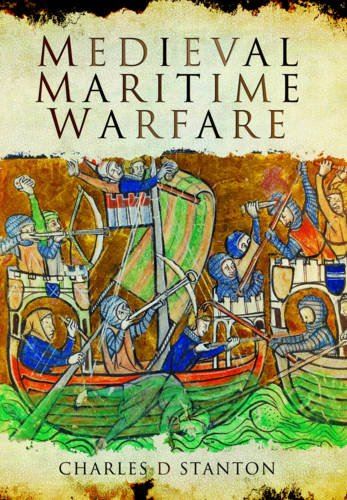Medieval Maritime Warfare
Charles D. Stanton
 When contemplating the brutal and challenging nature of medieval warfare, few recall the significant naval actions which accompanied the medieval world’s military engagements. In Medieval Maritime Warfare, Charles Stanton chronicles the history of naval warfare, tactics, and ship construction during the Middle Ages. To best explain and contextualize the period’s maritime warfare, the author splits his narrative into two sections: southern and northern Europe. Natural forces and geography conspired to create two drastically different maritime environments, thereby two different maritime cultures on the Mediterranean and the northern seas. Through a detailed examination of historical records, recent scholarship, and the archaeological record when necessary, Stanton comprehensively documents the fitful history of maritime warfare in Medieval Europe.
When contemplating the brutal and challenging nature of medieval warfare, few recall the significant naval actions which accompanied the medieval world’s military engagements. In Medieval Maritime Warfare, Charles Stanton chronicles the history of naval warfare, tactics, and ship construction during the Middle Ages. To best explain and contextualize the period’s maritime warfare, the author splits his narrative into two sections: southern and northern Europe. Natural forces and geography conspired to create two drastically different maritime environments, thereby two different maritime cultures on the Mediterranean and the northern seas. Through a detailed examination of historical records, recent scholarship, and the archaeological record when necessary, Stanton comprehensively documents the fitful history of maritime warfare in Medieval Europe.
Stanton begins with the southern theater. Providing initial background with the Roman expedition to Africa, the author transitions into the almost perpetual Byzantine and Muslim fight for control over the Mediterranean, continues to the ascendancy of the Norman Kingdom in southern Italy, and concludes with the maritime rivalry of Genoa and Venice. In doing so, Stanton references many contemporary texts, often including lengthy quotations, in order to capture the context of the many battles, campaigns, and innovations, as well as how the medieval world reacted to them. The author’s robust knowledge of the Norman conquest of Italy is evident, as he describes their mastery of sea power during their dominance of the central Mediterranean. He also notes, rightly so, that their conquest of Sicily set the stage for later maritime powers to expand to the Middle East.
In the book’s second part, Stanton delves into the differences in ship construction and design between the Mediterranean and northern Europe. As the author rightfully points out, archaeological studies of the Bremen cog and the Skudelev viking ships have illuminated much about how northern Europeans constructed naval vessels and conducted maritime warfare. Additionally, northern European naval strategy differed from their southern neighbors. Whereas the Mediterranean witnessed pitched galley engagements and quick amphibious assaults on coastal cities, the clinker-built northern vessels served almost exclusively as troop transports, with the exception of the viking Invasions. The only complaint regarding this section is its brevity, perhaps due to the lack of primary source material on events separate from English and French history.
The most captivating portion of Stanton’s volume remains his explanation of maritime power during the Crusades. Even though the section is discussed within the Mediterranean portion of the book, the Holy Wars brought Europe’s northern realms to the Mediterranean and the Middle East, briefly intertwining the two European maritime cultures. Focusing on the Third Crusade, Stanton reveals the crucial role which the European fleet had during Richard the Lionheart’s campaign in the Levant. Not only did the fleet maintain supplies to the crusaders, but it played a pivotal role in neutralizing Saladin’s naval forces. Additionally, the author uses the context of the Crusades to explain the ascendancy of the Italian maritime states, Pisa, Genoa, and Venice.
Charles Stanton’s Medieval Maritime Warfare chronicles naval warfare through an oft neglected period of maritime history. As such, recreating the narrative, especially when seeking to explain tactics and vessel construction, presents a significant challenge. Nevertheless, the author provides a thoroughly researched compendium which explains the rise and fall of contemporary maritime powers and the paradigm shifts which impacted ship design, naval tactics, and the maritime paradigm of the age. Additionally, the author’s inclusion of many archaeological studies of shipwrecks, particularly in Northern Europe, supplement the historical narrative nicely and direct the reader towards even further knowledge of the topic. Medieval Maritime Warfare is the perfect work for those eager to introduce themselves to maritime warfare during the Middle Ages.
- Barnsley: Pen & Sword Maritime, 2020
- 6” x 9”, softcover, vii + 359 pages
- Illustrations, diagrams, maps, notes, bibliography, index. $34.95
- ISBN: 9781526782199
Reviewed by: William Nassif, University of South Carolina
